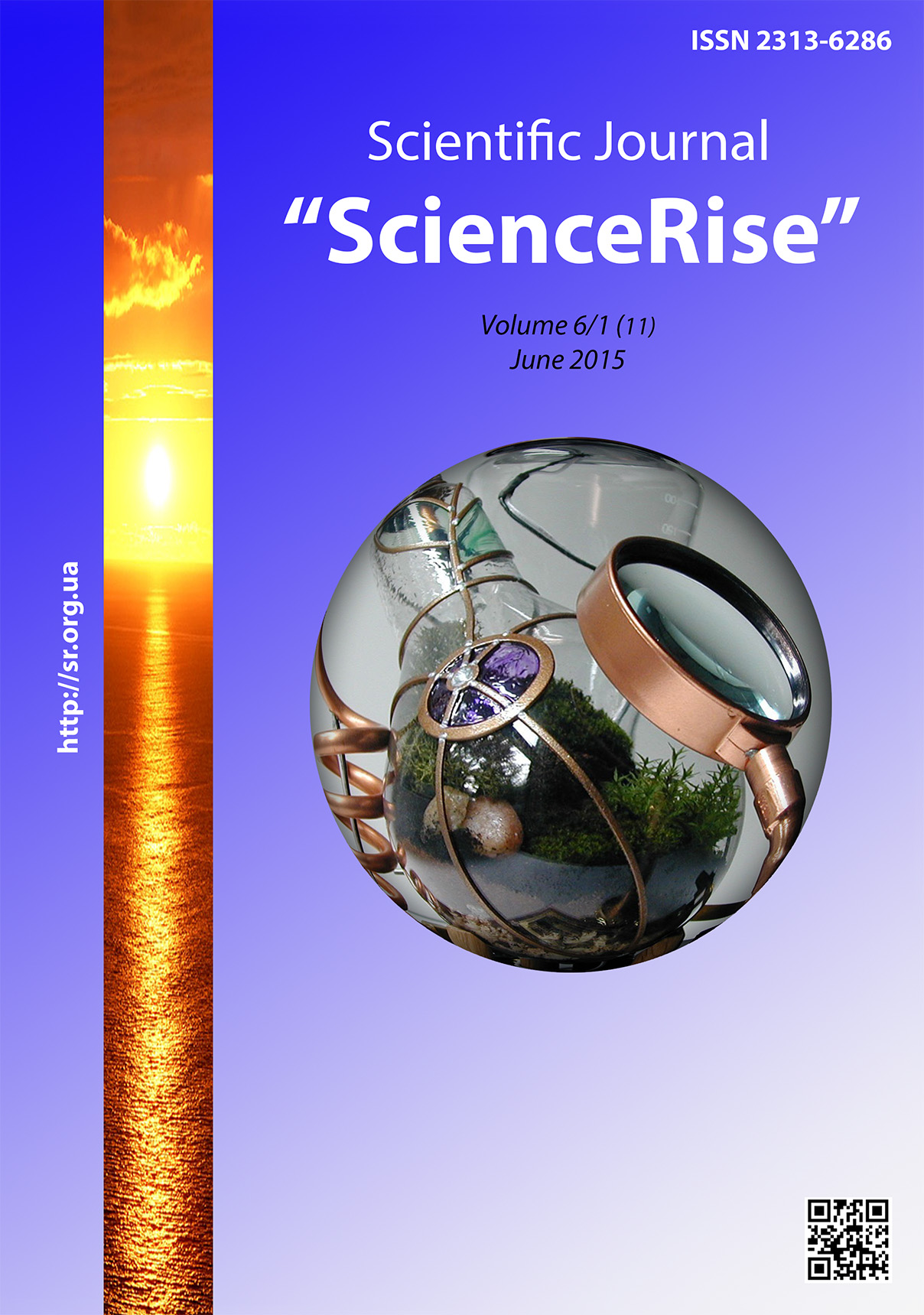New enzymatic method for l-arginine determination based on use of human arginase i and urease
DOI:
https://doi.org/10.15587/2313-8416.2015.45126Keywords:
enzymatic assay, arginase I, urease, o-Phthalaldehyde, L-arginine, urea, ammonium, spectrophotometryAbstract
It is developed a sensitive and selective method for quantitative analysis of L-arginine with spectrophotometric method of detection of the reaction product (ammonium) using o-Phthalaldehyde. The method is based on the use of highly purified arginase I and commercial urease. The new method is highly sensitive for L-arginine determination, a wide range of linearity and insensitivity to interfering influence of wide range of amino acids
References
Yokoro, M., Suzuki, M., Murota, K., Otsuka, C., Yamashita, H., Takahashi, Y. et. al. (2012). Asymmetric Dimethylarginine, an Endogenous NOS Inhibitor, Is Actively Metabolized in Rat Erythrocytes. Bioscience, Biotechnology and Biochemistry, 76 (7), 1334–1342. doi: 10.1271/bbb.120086
Rotondo, R., Mastracci, L., Piazza, T., Barisione, G., Fabbi, M., Cassanello, M. et. al. (2008). Arginase 2 is expressed by human lung cancer, but it neither induces immune suppression, nor affects disease progression. International Journal of Cancer, 123 (5), 1108–1116. doi: 10.1002/ijc.23437
Lam, T.-L., Wong, G. K. Y., Chow, H.-Y., Chong, H.-C., Chow, T.-L., Kwok, S.-Y. et. al. (2010). Recombinant human arginase inhibits the in vitro and in vivo proliferation of human melanoma by inducing cell cycle arrest and apoptosis. Pigment Cell & Melanoma Research, 24 (2), 366–376. doi: 10.1111/j.1755-148x.2010.00798.x
Glazer, E. S., Stone, E. M., Zhu, C. et al. (2011). Bioengineered human arginase I with enhanced activity and stability controls hepatocellular and pancreatic carcinoma Transl. Oncol, 4 (3), 138–146.
Glazer, E. S., Stone, E. M., Zhu, C., Massey, K. L., Hamir, A. N., & Curley, S. A. (2011). Bioengineered Human Arginase I with Enhanced Activity and Stability Controls Hepatocellular and Pancreatic Carcinoma Xenografts. Translational Oncology, 4(3), 138–146. doi: 10.1593/tlo.10265
Morales, S. M. Cystinuria: diagnosis and therapeutic approach. (2011). An. Sist. Sanit. Navar, 34 (3), 453–461.
Lacroix, C., Caubet, C., Gonzalez-de-Peredo, A., Breuil, B., Bouyssié, D., Stella, A. et. al. (2014). Label-free Quantitative Urinary Proteomics Identifies the Arginase Pathway as a New Player in Congenital Obstructive Nephropathy. Molecular & Cellular Proteomics, 13 (12), 3421–3434. doi: 10.1074/mcp.m114.040121
Cohen, S. I. (1960). The determination of arginine released in human blood plasma after plasminogen activation. Use of a cation-exchange resin. Archives of Biochemistry and Biophysics, 86 (2), 166–168. doi: 10.1016/0003-9861(60)90397-0
Costin, J., Paul, F., Lewis, S. (2003). Selective determination of amino acids using flow injection analyses coupled with chemiluminescence detection, Anal. Chim. Acta., 408 (1), 67–77.
Fritz, J. H. (2013). Arginine Cools the Inflamed Gut. Infection and Immunity, 81 (10), 3500–3502. doi: 10.1128/iai.00789-13
Gayda, G. Z., Stasyuk, N. Ye., Gonchar, M. V. (2014). The methods of L-Arginine analysis (Review), Biotechnologia Acta, 7 (1). 31–39. doi: 10.15407/biotech7.01.031
Stasyuk, N.,Smutok, O., Gayda, G. et al. (2011). A new bi-enzyme potentiometric sensor for arginine analysis based on recombinant human arginase I and commercial urease. J. Mater. Sci. Eng. A., 1 (6), 819–827.
Stasyuk, N., Smutok, O., Gayda, G., Vus, B., Koval’chuk, Y., Gonchar, M. (2012). Bi-enzyme l-arginine-selective amperometric biosensor based on ammonium-sensing polyaniline-modified electrode. Biosensors and Bioelectronics, 37 (1), 46–52. doi: 10.1016/j.bios.2012.04.031
Stasyuk, N. E., Gaida, G. Z., Gonchar, M. V. (2013). L-arginine assay with the use of arginase I. Appl Biochem Microbiol, 49 (5), 529–534. doi: 10.1134/s000368381305013x
Mira de Orduña, R. (2001). Quantitative Determination of l -Arginine by Enzymatic End-Point Analysis. Journal of Agricultural and Food Chemistry, 49 (2), 549–552. doi: 10.1021/jf000522y
Gaede, G., Grieshaber, M. (1975). A rapid and specific enzymatic method for the estimation of l-arginine. Analytical Biochemistry, 66 (2), 393–399. doi: 10.1016/0003-2697(75)90606-5
Stasyuk, N., Gayda, G., Gayda, A. et al. (2011). The synthesis of affinity sorbents for purification of human arginase I from the recombinant yeast Hansenula polymorpha. Proc. Shevchenko Sci. Soc. Ser. Biochem, 28, 139–149.
Menshykov, V. V. (1987). The methods of laboratory investigations in clinical diagnostics. Мoscow: Мedicine, 215–219.
Kuo, M. T., Savaraj, N., Feun, L. G. (2010). Targeted cellular metabolism for cancer chemotherapy with recombinant arginine-degrading enzymes. Oncotarget, 1 (4), 246–251.
Goyal, S. S., Rains, D. W., Huffaker, R. C. (1988). Determination of ammonium ion by fluorometry or spectrophotometry after on-line derivatization with o-phthalaldehyde. Analytical Chemistry, 60 (2), 175–179. doi: 10.1021/ac00153a016
Ekanayake, S., Skog, K., Asp, N.-G. (2007). Canavanine content in sword beans (Canavalia gladiata): Analysis and effect of processing. Food and Chemical Toxicology, 45 (5), 797–803. doi: 10.1016/j.fct.2006.10.030
L-Arginine/Urea/Ammonia, UV method. Available at: https://www.nzytech.com/products-services/analytical-test-kits/ak00171/
Stasyuk, N. Ye., Gayda, G. Z., Gayda, A. V. et al. (2012). Enzymatic assay of L-arginine by the use of recombinant human arginase I. Ukrainica Biorganica Acta, 1, 31–37.
Downloads
Published
Issue
Section
License
Copyright (c) 2015 Галина Зуфарівна Гайда, Наталія Євгенівна Стасюк, Суренівна Єпрємян Хасмік, Михайло Васильович Гончар, Софія Ростиславівна Басс

This work is licensed under a Creative Commons Attribution 4.0 International License.
Our journal abides by the Creative Commons CC BY copyright rights and permissions for open access journals.
Authors, who are published in this journal, agree to the following conditions:
1. The authors reserve the right to authorship of the work and pass the first publication right of this work to the journal under the terms of a Creative Commons CC BY, which allows others to freely distribute the published research with the obligatory reference to the authors of the original work and the first publication of the work in this journal.
2. The authors have the right to conclude separate supplement agreements that relate to non-exclusive work distribution in the form in which it has been published by the journal (for example, to upload the work to the online storage of the journal or publish it as part of a monograph), provided that the reference to the first publication of the work in this journal is included.

